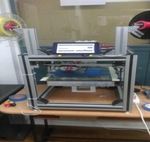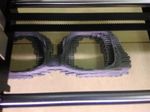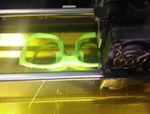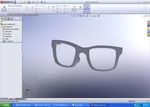ADDITIVE TECHNOLOGIES AND MATERIALS USED FOR MAKING CUSTOMISED GLASSES FRAMES
←
→
Page content transcription
If your browser does not render page correctly, please read the page content below
Additive Technologies and Materials Used for Making Customized Glasses Frames
ADDITIVE TECHNOLOGIES AND MATERIALS USED FOR MAKING
CUSTOMISED GLASSES FRAMES
Daniel Besnea1, Dana Rizescu2, Ciprian Ion Rizescu3,
Victor Constantin4, Alina Spanu5
1,2,3,4,5University POLITEHNICA of Bucharest, Faculty of Mechanical Engineering and Mechatronics,
Department Mechatronics and Precision Mechanics
E-mail: d_bes@yahoo.com , dana.rizescu@upb.ro , ciprian.rizescu@upb.ro,
victor.f.constantin@gmail.com , spanu_alina@yahoo.com
Abstract: In the paper describes a method for making seeing glasses frames by means of additive
technologies with the presentation of the main functional characteristics based on solid material
deposition, the FDM technology, as well as the main materials used (ABS, PLA, Wood PLA
composites), highlighting the properties and the technical and functional characteristics of the
materials used in making custom eyewear frames according to the individual facial characteristics
of each person but also by the specific ocular parameters.
Keywords: Additive technologies, materials specific to 3D technologies, personalized glasses
frames.
1. Introduction -rail glasses of other materials: wood; turtle
shells characterized by being very expensive; animal
Eyeglasses are a tool that can help to correct eye horns, can be hand-processed by embedding
defects or can be used as protection. They consists of different materials, obtaining individualized frames.
two lenses and a frame for the glasses, the main role For the optician to recommend the best eyewear
of the glasses frames is to position the lens as to the client, the following elements should be
accurately as possible on the optical axis of the eye. known: the shape of the skull, forehead, nose, face
The glasses frame is made up of a lens holder called a physiognomy, shape and position of the ears. To the
frame, the eye and nasal socket. It is generally facial shape of the client. The optician must be
recommended that the lens catches on its entire careful that the frame does not press nerves and
circumference, but the lens may be in contact with blood vessels because it can produce unpleasant
the frame only in certain areas. sensations to the eyes. Also, in cases where the face
Frames for glasses can be made of the following of the client is not symmetrical the optician must
materials: plastics, metal materials or combinations recommend the proper eyeglasses. The shape of the
of plastics with metallic materials known as mixed nose is a criterion for choosing suitable eyeglass
frames. frames. By choosing a suitable nosepiece of the
From the point of view of the materials from eyewear to fit perfectly with the shape of the nose, it
which glasses are made, the frames of spectacles can can give the face more harmony. When the nose is
be classified as follows: aquiline or nasal it is recommended to be deeper,
- metallic glass frames made of stainless steel when the nose is too small, or it will be tall.
is the most used material because it is cheap and An eyeglass must meet primarily its medical role
resistant, gold in alloy with other materials like of fixing the lens at a distance of 12 mm from the
silver, copper, zinc, nickel, a combination that eyeball, to match the optical axis of the glasses to
increases hardness and alloy resistance 4-5 times; coincide with the eye axes of the eye, not to damage
titanium, is a very lightweight material, but at the the field of vision. Consideration should also be given
same time very mechanical and corrosion resistant, to the purpose of the eyewear if it is for distance, for
if desired, it can be coated with a gold alloy; also reading, for physical exercise, for sports or as
cobalt is light, flexible and corrosion resistant; sunglasses.
- plastic glasses frames made of cellulose, For a round face a frame of rectangular, square,
epoxy resin with thermoplastic properties with the trapezoid or diamond shape it is recommended to
advantage that it is very light and can be colored; contrast the face. For a rectangular or diamond
carbon fibbers characterized by high mechanical shaped face, oval frames are recommended, for a
strength and elasticity and low density; square face, round or oval frames are recommended,
in dark colours, for a heart-shaped face - round or
International Journal of Mechatronics and Applied Mechanics, 2018, Issue 3 13Additive Technologies and Materials Used for Making Customized Glasses Frames
oval shaped frames with thin, colourful and light- In recent years, a large number of innovative
colored frames, and for an oval face almost any (Rapid-Prototyping) technologies have been
frame, from round to square. Frame in the shape of a developed to transform the concept of achieving a
butterfly prints to the young girl, joy, make it complex product into a solid replica in a short period
friendlier. The rounded faces give the face fine, of time. [1, 2].
sweet, rectangular or square shapes face seriously. Generally, Addition Material (AM) systems are a
Frame width can change the look of the face. On an new class of virtual physical realization technologies
elliptical or oval face, the frame should not exceed using a family of special equipment. They provide
the contour. The frame of the frame must match that the addition or bonding of material in successive
of the eyes, the hair, the eyebrows and the sections as much as needed and where it is
complexion. A light frame will make a white face necessary. The production processes by adding
even more pale and a darker frame on a darker material using solid matter in a solid state can be
complexion it will darken you even more. Also, a described as systems that take the virtual 3D
darker frame does not fit a face with a very light face, geometric model of a three-dimensional object and
revealing the too much difference in nuances. It is of generate a physical replica of it, the raw material can
great importance and the forms of the hinge be in the form of yarns foil. One of these additive
applications. The vertical and narrow ones take of technologies is FDM (Fused Deposit Modelling), a
the width of the frame, the horizontal ones a lattice. process based on the extrusion of material using a
The shape and size of the frames should provide a yarn of different material qualities (polyamide,
field of vision adapted to everyday needs, the frames nylon, wax), which it heats up to a temperature a few
of the glasses that are placed and removed from the degrees below the melting temperature, then
head frequently must be more resilient than those reduces its diameter to 0.12-0.15 mm by extruding it
for rarely sunglasses (bifocals, progressive), frames into a depositing device, a device moving the XOY
of the glasses for children will not have the same plane to materialize a section of the 3D virtual
proportions as adults, they should provide a higher model. The key to the process is to rigorous control
visual field, they should be lightweight and made of of the temperature at which the material is heated
durable materials, and glasses should be comfortable and maintained during the deposition. The material
and as stable as possible on the head. [4;7] used can be an ABS wire that is heated at a
temperature 270 C, where the material is in a semi
2. Technologies and Materials for liquid state, and can be extruded through a very
Personalized Spectacle Frames Through small diameter nozzle (0.254 mm or 0.127 mm). The
extruded plastic material in the semi liquid state can
Additive Technologies be displaced together with the heated head on which
it is fastened. This movement is done in the XOY
The emergence of Additive Manufacturing (AM) plane, the movement being numerically controlled
technology in the early 1990s was a milestone in on the computer. The construction part is on a
research and technology development. The new AM platform that moves vertically, along the Z axis,
technologies are the result of intense research and motion controlled numerically by the 3D machine
progress in various areas: from fine mechanics to control equipment, fig. 1. In this way a piece can be
numerical controls, from laser technology to three- made by depositing the material where the
dimensional modelling packs, from IT to material configuration of the piece demands it. [1]
science. Rapid Prototyping technologies allow for a
great flexibility in application, an advantage to
exploit micro components with a good dimensional
precision used as conceptual models / functional
prototypes or indirectly used as master models for
the production of flexible tools for the manufacture
of metallic or non-metallic parts in individual or
small series production.
3D technologies allow you to assess the visual
needs of the wearer taking into account the facial
features and eyewear framing in accordance with
eye parameters according to the individual facial
physiognomy of each person but also to the unique
design of the eyeglass frames. Also, 3D printing
allows for the realization a suite of frames, designs
and colours, the glasses being customizable with the
name, customer initials, and the complementarily of
the frames to adjust to any facial profile. Fig. 1 FDM working principle [2].
14 International Journal of Mechatronics and Applied Mechanics, 2018, Issue 3Additive Technologies and Materials Used for Making Customized Glasses Frames
The article presents the technology for making The PLA - Stone mixture is recommended for
glasses customized by the FDM process, using three objects that look nice with a texture similar to the
types of PLA (polylactide), ABS (Butadiene styrene stone. 3D Printed Architecture Machetes can have
acrylonitrile) and a Wood-PLA composite material. stone-like components (or can be built entirely with
PLA (Figure 2) is a brilliant, hard and biodegradable this material). Other 3D printable objects with this
substance that is a more powerful and flexible material: statuettes, busts, small bas-reliefs, candle
material for the 3D printer. PLA chemically contains holders, etc.
lactic acid and lactide. This has a low melting The PLA - Wood mix, available in 2 variants,
temperature of 173-178 ° C and a traction resistance offers a special, smooth texture with a colour that
of 2.7-16 GPa with several application areas, tends to open wood, such as Balsa or coconut wood
including medical implants and compostable darker in colour that can give the character of the
packaging materials. PLA is mainly obtained by glasses' uniqueness. [3]
processing plants such as corn, sugar beet, potatoes,
sweet smell, no hazardous components, considered 3.Execution of Custom Glasses Frames
compatible with the environment and which can Using the FDM-Fused Deposition
come into contact with food and therefore
environmentally friendly.
Modelling Process
The manufacturing process using the FDM system
comprises of three main stages, namely the pre-
processing stage, the actual construction stage of the
part and the post processing stage. During the pre-
processing stage the CAD model of the part is loaded,
fig. 3, designed in the Solid Works 3D design
environment [5,6], in the Quick Slice specialized
Fig. 2 PLA – chemical structure. program - a program that generates the FDM
machine code where the CAD model is located in the
Stronger and more rigid than ABS, PLA is more workspace of the machine so that the piece
complicated to use in assembling parts that require construction is optimal in terms of working time and
bonding, and the deformation property at material consumption.
temperatures lower than the ABS (about 65ºC)
prevents its use in engineering projects.
ABS (Butadiene styrene acrylonitrile, a highly
versatile polymer used in many industries and
exhibiting a variety of properties), in 3D printing, the
ABS is a hard plastic, high temperature resistant (it
begins to deform at about 100 ° C) and with slight
flexibility (compared to PLA) which helps to achieve
the objects that require joining. It is soluble in
acetone - with a brush soaked in acetone, the
surfaces can be easily finished, becoming shiny, and
the various parts of an object can be glued together.
In large dimensions, it presents a risk of
deformation. Certain manufacturers have modified
the materials specified above, in particular PLA, to Fig. 3 CAD model of the personalised eyeglasses.
obtain materials with new aesthetic and structural
properties: flexible, phosphorescent or mixed with After the orientation of the CAD model, its
wood or stone particles. These materials are sectioning is carried out with planes parallel to the
specially designed to give objects a unique finish, but plane of the machine (horizontal planes), operation
also certain qualities as required. resulting in several sets of level curves called
Flexible material can be used for objects that are perimeters. The sectional section along the Z axis is
subject to stretches or compressive forces, from 0.2 mm is chosen according to the diameter of the
fashion design (e.g. a shoe, a frame of glasses) to extrusion nozzle diameter, in the case presented in
engineering (a robot with multiple components that the article the diameter of the extrusion nozzles is
can withstand small shocks etc. 3D phosphorescent 0.4 mm. The Quick Slice program [8] generates the
print media can create objects that light up in the paths that the extrusion device must follow to
dark. materialize section of the piece, fig. 4.
International Journal of Mechatronics and Applied Mechanics, 2018, Issue 3 15Additive Technologies and Materials Used for Making Customized Glasses Frames
Fig. 4 Slicing of the model using Quick Slice
In the stage of construction of the piece areas corresponds to the full areas of the piece, after
manufacturing the extrusion head of the machine the entire section is fully materialized, the platform
deposits a thin wire of construction material along descends with a step equal to the section of the
the curves defining the perimeter of the section and virtual model and the entire process resumes for a
after the materialization of the perimeters the new section until the last section of the virtual model
deposition of the building material takes place in the of the piece is materialized, fig. 5.
c
a b
d
e f
Fig. 5 Achieving ABS and PLA glasses on the Wanhao 4S Duplicator printer with two print heads:
a - 3D printer overview; b-view stage realization of custom ABS glasses frame; c- custom lens glasses made of ABS
with lenses; d - viewing the frame of personalized glasses from PLA; e - view personalized glasses frame with
sacrificial layer; f - the two custom glasses frames made of ABS and PLA materials. [8]
For the manufacture of Wood -PLA composite The last post-processing step consists of
glasses, an experimental installation with two separating the work platform from the workpiece,
heating / extrusion heads has been used, with the removing the connecting element between the
following technical characteristics: 400 x 400 x 250 workpiece itself and the platform, removing the
mm working volume, WI-FI, SD / MMC card reader, supports (if any) and finishing the workpiece if
operating system Arduino / Repetier-Host, fig. 6. necessary.
16 International Journal of Mechatronics and Applied Mechanics, 2018, Issue 3Additive Technologies and Materials Used for Making Customized Glasses Frames
a b
c
d
Figure 6. a - Double extruder 3D printer general view b - composite material printing detail view;
c - print head trajectory;
d - personalised eyewear obtained from Wood –PLA.
4. Conclusions Acknowledgements
The main factors influencing the accuracy of This work was supported in part by University
execution obtained by the process FDM parts are Politehnica of Bucharest, through the “Excellence
precision .stl file that affect the precision part in that Research Grants” Program, UPB – GEX. Identifier:
its poor quality, translated by relatively large UPB–EXCELENŢĂ–2017 Research project title,
deviations from the original CAD model leads to Contract number 48/25.09.2017 ME14-17-05, ID98.
obtaining improper parts; the orientation of the
model in the working space of the machine is References
important from the point of view of the
manufacturing precision of the piece, because during [1] Petru Berce, Nicolae Balc, Cristian Caizar, s.a.,
the process, the elements that are made by Tehnologii de fabricatie prin adaugare de
contouring will result more precisely than the material şi aplicaţiile lor, Editura Academiei
elements that are made by construction; diameter Romane, Bucuresti,2014.
extrusion nozzle material influences the precision of [2] Bethany C. Gross, Joydo L Erkal, s.a., Evaluation of
execution of play in that according to it, will result 3D Printing and Its Potential impact on
section dimensions yarn made with diameters of Biotechnology and the Chemical Sciences, Anal
extrusion nozzle is greater, the more you increase Analytical Chemistry.
the section width wire material submitted, which [3] Ramji Pandey, Photopolymers in 3D printing
leads to limiting the possibilities of realizing the fine applications, Degree Thesis Plastic Technology,
details of the piece and to a lower precision; the step 2014.
of cutting the virtual model influences the execution [4] State D.M., Lascu E., Utilajul si tehnologia
precision of the piece through the so-called step confectionarii lentilelor, ramelor si ochelarilor,
effect that occurs during the construction process; E.D.P. Bucuresti, 1980.
the complexity of the piece and the fineness of the [5] Gordin Stoica Anca, Tehnologia monturilor de
details if the piece to be constructed contains ochelar, suport de curs.
elements of a size smaller than the dimensions of the [6] Mircea M. Popovici, Modelarea virtuala 3D in
thread of the deposited material, then these details constructia de masini, Editura Printech,
will be lost; the type of material used to make the Bucuresti, 2005.
piece influences its machining precision in that, [7] Ionut. G. Ghionea, Catia V5, Aplicatii in ingineria
depending on the material used, the diameter of the mecanica, Editura Bren, Bucuresti, 2009.
extrusion nozzle and the dimensions of the thread [8] www.solutions.3m.com
section of the deposited material are established. [1] www.wanhao3dprinter.com
International Journal of Mechatronics and Applied Mechanics, 2018, Issue 3 17You can also read



























































